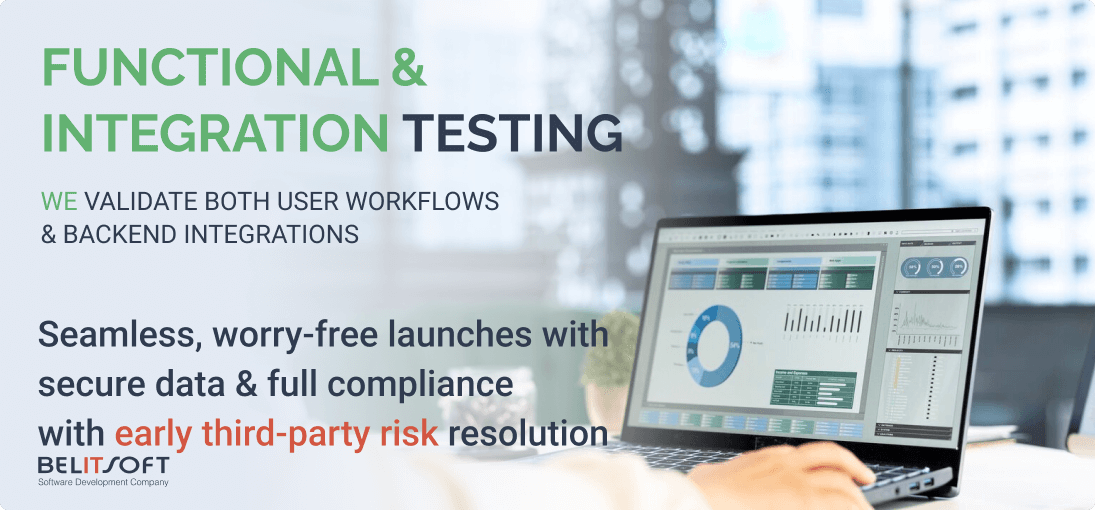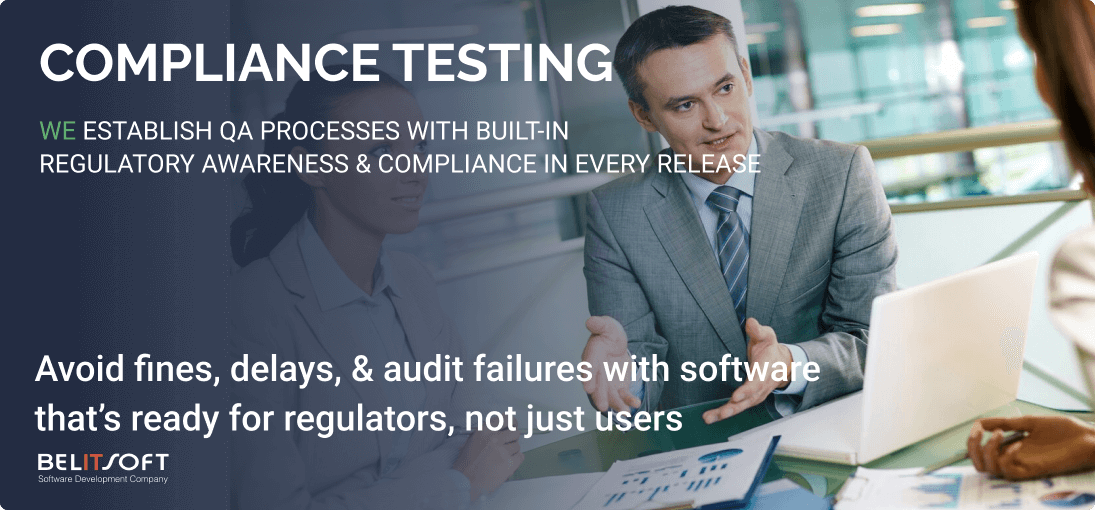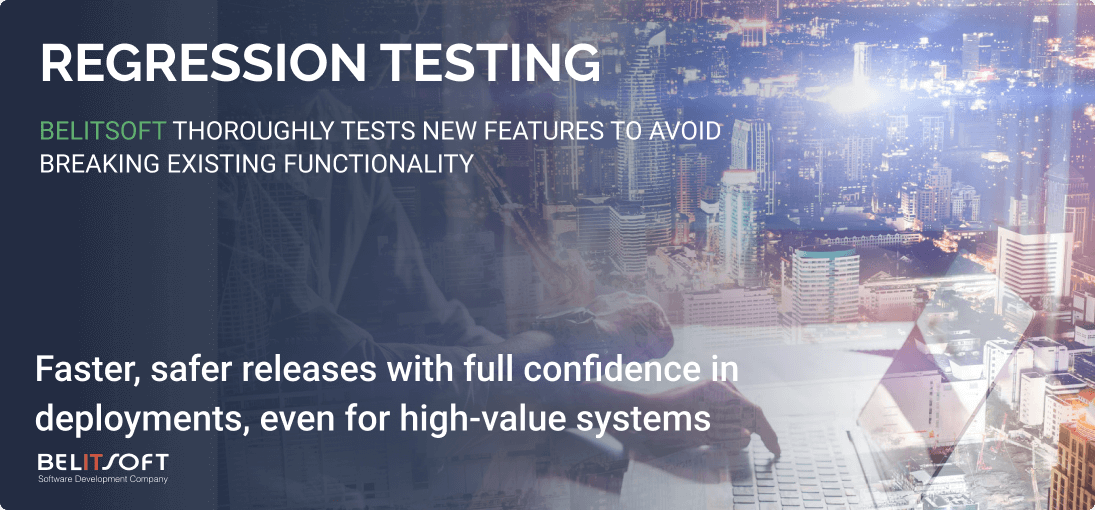In financial systems, you’re not testing if your automation script ran green, but whether the system still moves money, handles identities, calculates correctly, and doesn’t trigger a compliance call. It is about protecting revenue, enforcing compliance, and avoiding regulator fallout. Whether you are building something new or trying to keep legacy from breaking, this is what real QA looks like.
What Testing Really Means in Finance
From small advisory firms to global banks, the priorities are the same: protect funds, manage risk, stay ahead of regulation. Behind that is software. Financial institutions run on it. If the software fails, the business fails.
That includes everything from CRM systems to investment platforms, Big Data analytics, compliance tools, and audit systems. New apps get added fast. Legacy systems stay around. The result is complexity. When something breaks, you do not just lose a transaction, you lose customers, revenue, and legal standing.
Banking and financial services are now technology. Core functions, from onboarding to risk modeling to KYC, are entirely digital. Billions of transactions happen daily across web and mobile. Most of that rides on infrastructure that is expected to be flawless or thoroughly tested.
A bug in a payment gateway is not just about UX. It may cause financial loss, trigger regulatory review, and generate fines. A logic error in interest calculation can result in misstatements that require remediation and disclosure.
With mobile-first banking, digital account origination, and real-time transactions, release cycles are measured in days, not quarters. QA teams are expected to deliver full coverage under pressure: faster than ever, with less tolerance for error.

Financial systems don’t just show content. They move money, manage identities, enforce regulatory logic. They handle authentication, fraud controls, settlement flows, and trading pipelines. One missed condition in a rule engine or calculation logic, and you’re explaining it to compliance.
Belitsoft delivers automated software testing services built specifically for banks, fintechs, and financial platforms. Our quality assurance automation engineers understand how financial systems work - from transactions to compliance - so we know what needs to be tested, and why it matters.
What Users Expect — And What Systems Must Prove
End users are not reading about uptime SLAs. They are managing retirement accounts, trading ETFs mid-flight, checking budgets poolside. If your app stalls, breaks, or delays - you don’t lose a click, you lose trust.
Mobile banking has now surpassed internet banking. These apps are not companion tools. They are the primary financial control center for millions. They must operate flawlessly under real-world usage: load spikes, regional handoffs, API throttling, identity checks and fraud detection logic. Testing has to cover that. And not just the happy path: the broken sessions, the dropped packets, the compliance edge cases.
The Core Challenges of Testing Financial Software
Sensitive Data Cannot Be Treated Like Test Data
Financial applications run on personal, high-value, regulated data. Testing teams cannot use raw production data. That’s not just a best practice - it’s a compliance issue.
Testing environments require anonymized or synthetic datasets that behave like real data, but carry zero exposure risk. That means format-valid, domain-accurate, and traceable - not a redacted spreadsheet someone exported and forgot to delete.
Masking, anonymization, and secure data provisioning are prerequisites. Without them, you're building test coverage on a legal liability.
Scale Makes It Worse
Most financial applications don’t operate in simple workflows. They're multi-tiered, highly concurrent, and designed for both real-time and batch processing. High throughput is the baseline.
You’re not testing an app. You’re testing encrypted transactions, large-scale user sessions, real-time pricing engines, API chains, audit and recovery logic, reporting and compliance logs, data warehousing under retention requirements.
Domain Knowledge Is Not Optional
This is where most generic QA fails. Testers in finance need to understand how money moves. That includes: FX conversions, settlement flows, lending logic, risk scoring, trading workflows, KYC/AML paths, regulatory edge cases.
You cannot validate a risk engine, pricing model, or loan approval rule without knowing what the system should do - not just what the spec says. Domain fluency is a baseline, not a bonus.
The Cost of Mistakes Is Measured in Real Money
Every missed bug has downstream consequences: security breaches, broken compliance audits, product delays, user attrition, regulator inquiries, missed SLA thresholds, financial exposure.

Types of Software Testing In Financial Services
Functional & Integration Testing
Functional Testing
You test the application logic. Does it work: calculate, follow the rules, etc.? That means account creation, fund transfers, loan approvals, payment execution, dashboard reporting, etc. Each test confirms the platform behaves exactly as it should for users, regulators, and auditors.
Integration Testing
No system runs alone. Financial apps pull from CRMs, loan engines, identity providers, fraud tools, payment processors and gateways, trading platforms, merchant systems, internal APIs, bureaus, regulators. If the data doesn’t flow, the system fails, even if the UI looks fine. Integration testing checks data synchronization across systems, error handling when a dependency fails, secure transmission of PII, response time under normal and peak conditions, etc.

Compliance Testing
You’re not testing features. You’re testing whether the system can survive an audit.
Financial platforms operate under constant regulatory pressure - SOX, PCI DSS, GDPR, Basel III. Every release has to prove compliance.
The QA suite must validate the things that regulators will ask about:
- Data Privacy. Encryption, masking, and PII protection across environments
- Audit Trails. Transactions, edits, and events - all timestamped, tamper-proof, and queryable
- Transaction Integrity. Every calculation is accurate, consistent, and reproducible
- Access Controls. Role-based restrictions that work everywhere, not just in production
- Disaster Recovery. Failover plans that work. Backups that restore. Evidence that both are tested.
Automation helps, but only if it’s built to cover real regulatory logic. "Green test results" mean nothing if your coverage misses data residency, privacy enforcement, or cross-border compliance checks.
Compliance isn’t static. Frameworks change. New rules show up. You need testing that adapts - and proves that your system can handle it.

If you're operating across multiple jurisdictions, the rulebook multiplies: RBA, ASIC, APRA (Australia), CFPB, FTC (USA), RBNZ, FMA, Privacy Commissioner (New Zealand), SBV, SSC (Vietnam), etc.
Each body brings its own review process, documentation requirements, and audit expectations - all tied to the financial product, region, and user group.
You don’t pass this with a checklist. You pass it with a system that holds up under scrutiny.
Security Testing
Financial systems handle everything attackers want: personal data, payment flows, authentication tokens, and the logic that controls payouts.
Tests must cover it and simulate abuse. That means forcing credential misuse, invalid session tokens, malformed transaction payloads to prove resistance.
Security checks don’t start when code is "ready". They run with it. Penetration tests need to be continuous. Encryption has to be verified with inspection, not assumed because the config file says so. Permitted functions are accessible and restricted functions are not accessible according to the user’s role or job title.

Performance and Stress Testing
Financial platforms fail under pressure: market spikes, month-end loads, concurrent sessions, salary disbursements. Performance testing confirms system behavior under real load.
Most high-volume systems don’t crash in staging, but in production. Load testing helps prevent that by simulating production behavior before production is involved.
Stress testing pushes that further. You don’t guess where it breaks: you find it out. That includes high-volume transfers, simultaneous logins, batch events. Any time the traffic goes high.
Latency testing measures response times for real-time trading/payments.<.p>
You test for concurrent users under volatile traffic, system limits under forced degradation, and how fast the system recovers when it buckles.

Disaster Recovery Testing
Backups aren’t counted until they’re restored cleanly. Failover isn’t accepted until it happens under real load.
Specialized Financial Testing
Risk scenario testing for simulating market crashes, fraud attempts and liquidity crises.
End-of-Day batch testing for overnight processing validation.
Reconciliation testing for ensuring that transactions are matching across ledgers, bank statements and reports.
Currency and Localization testing for multi-currency handling, tax rules and regional compliance checks.
Regression Testing
Release cycles are shrinking. The pressure to deliver is constant. Every feature added introduces more paths, more data conditions, and more opportunities for something to break in a way that no UI script will ever catch.
Every update, patch, or release adds risk. Regression testing is how you contain it.
You’re proving that nothing critical broke in the process of adding new features, especially in revenue-producing or compliance-bound flows. Existing features must still function, logic paths must remain stable, no silent failures, no downstream side effects, no audit-triggering regressions in reporting or calculation.
A modular, evolving regression suite keeps coverage aligned with the platform. It needs to grow with the product, and not get replaced sprint by sprint.
Regression testing is the only way to ship with confidence when the system is already in production.

Test Automation for Financial Services
Manual testing can't track change at the speed it happens, and it doesn’t scale. By the time you’ve finished validating one release, three more are coming.
If a test runs every release, it should already be automated.
That’s where automation comes in place: core workflows, high-risk paths, anything repeatable. Run it nightly or trigger it in the pipeline.
Test automation tools simulate real users, log everything, run tests in parallel, and don’t get tired.
But this isn’t about full automation. That’s a fantasy. You automate what pays off. Everything else waits. Financial systems are expensive to test. So it’s done in stages. Modular.
Test Automation for Regression and API testing as well as AI/ML based testing for anomalies in transaction patterns detection (fraud detection) are considered to be the best practice for Automation in Financial systems.
Testing Process for Financial Services
Use a structured QA workflow: adaptable, but strict.
- Analysis & Planning. Understand business rules, compliance needs and risks. Define the scope, set objectives, and pick tools.
- Test Design & Case Development. Write the test cases. Map data requirements. Confirm coverage against regulatory and technical baselines.
- Environment Setup. Build isolated, compliant test environments. Mirror production architecture as closely as possible.
- Execution. Run the tests. Manual and automated. They run, they log, and failures get tracked to root.
- Issue Resolution. Fix defects. Verify the fixes. Use regression to confirm nothing else broke while patching.
- Retesting. Re-run the failed paths. Validate fixes hold. Check for downstream issues introduced by the change.
- Release Approval. Everything passed? Logs clean? Coverage holds? Vulnerabilities mitigated? Then you ship.
- Audit and Continuous Improvement. Strengthen future testing by learning from past gaps: review critical bugs that slipped through, update your test repository.
What Financial QA Teams Bring
Testing financial systems requires more than automation coverage. Yes, automation frameworks help. Yes, shift-left practices reduce risk. But unless the test team understands what matters, and how failure propagates downstream, they’re just running checklists.
Financial QA means building coverage that’s audit-proof, risk-aware, and designed for volatility.
Internal teams may be overloaded, or unfamiliar with the testing domain. Testing gets squeezed between delivery targets and audit timelines. That’s where external QA partners come in.
When internal teams hit their limit, outside specialists do more than fill gaps. Firms that offer software testing for financial services bring:
- Domain-aligned engineers who know what to test and what not to miss
- Custom strategies, not templates
- End-to-end test ownership, including test data management, security controls, and field-level reconciliation
- Tool expertise across modern stacks: mobile, desktop, API, cloud, data-heavy systems
QA in this space includes everything from test case design to release signoff and risk ownership through each phase.
We support overloaded or growing teams with custom testing strategies, not one-size-fits-all templates. Our testing team understands how financial software fails, and how to catch issues before they reach production.
How Belitsoft can Help With Testing
We work with retail and merchant banks, investment houses, credit bureaus, insurers, and fintechs that move fast. Often faster than their test coverage.
We test where the risk is, nothing else:
- Core financial platforms. Stability, security, accuracy. If it moves money or stores identity, we test it first.
- Banking apps. Cross-device behavior, session handling, authentication. No UI passes if the state breaks on resume.
- Compliance workflows. FCA, PCI, GDPR. We validate controls, data handling, and audit paths.
- Fintech stacks. Third-party APIs, chained microservices, async delays. We test what happens when external dependencies don’t behave.
- Load scenarios. Stress under transaction spikes, concurrent sessions, and batch jobs. What breaks gets fixed before production.
- Penetration points. External and internal surfaces. Known exploits. Simulated misuse. We don’t assume the firewall holds.
- Risk and fraud systems. Rules engines, signal noise, false positive tuning.
- Data pipelines. Integrity checks, reconciliation logic. We test for gaps between source and output to find the mismatch.
- Mobile interfaces. Multi-device behavior. No lags, no state loss, no friction. Just reliable flow, end to end.
Testing work spans several layers:
- Manual testing for edge cases, flows with too much nuance to automate, or systems still in transition
- Test automation using scalable frameworks, maintainable code, and repeatable patterns - built to last beyond the first sprint
- QA outsourcing for when teams need immediate lift without hiring delays
- QA consulting to refactor in-house processes or redesign flaky test suites
- Full QA management, from planning to sign-off, across delivery pipelines
Projects range from modernizing legacy systems to greenfield fintech apps. Everything from thick-client platforms to microservice-heavy backends is in play.
Our QA setups use:
- Physical devices for mobile and cross-platform testing
- Cloud-based testing infrastructure to reduce on-premise drag
- Environments tuned for high-throughput, secure, and parallel execution
- Onshore, nearshore, or offshore coordination models depending on compliance and project load
Test artifacts live in CI/CD pipelines. Reports are integrated. Slack, Teams, and Jira are used for triage and resolution in live windows.
We run:
- Database-level testing alongside front-end flows
- Full-stack automation across UI, API, integration points, and data pipelines
- Smoke, regression, and visual regression for each release
- End-to-end validation with built-in rollback checks
- Specialized Financial Testing
Test data is managed with care. Validation runs are tracked.
With proper test automation in place, we provide higher release confidence, shorter onboarding time for new engineers, reduced manual test overhead: in some cases, 70%+ reduction, stability across high-volume workflows and fewer production rollbacks.
We use the right test automations stack, and apply the right discipline.
For financial products, project-based testing isn’t always enough. That’s where a dedicated Testing Center of Excellence comes in. We operate as your remote QA partner, building your test strategy, handling daily execution, and supporting your dev team long-term. You focus on the business. We’ll handle the quality.
Partner with Belitsoft to outsource financial QA to a team that knows the systems, the risks, and the regulations. From preparing safe test data to making sure your software is ready to launch, we take ownership of the QA process, so you don’t have to worry about gaps. Contact our team to secure audit-proof QA, tailored to your financial workflows.
Rate this article
Recommended posts
Portfolio
Our Clients' Feedback


















.jpg)
.jpg)
.jpg)
.jpg)
.jpg)
.jpg)
.jpg)
.jpg)
.jpg)
.jpg)
.jpg)
.jpg)
.jpg)
.jpg)
.jpg)
.png)
.jpg)
.jpg)
.jpg)
.png)



















We have been working for over 10 years and they have become our long-term technology partner. Any software development, programming, or design needs we have had, Belitsoft company has always been able to handle this for us.
Founder from ZensAI (Microsoft)/ formerly Elearningforce